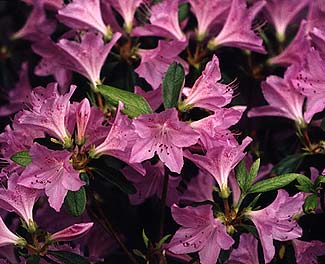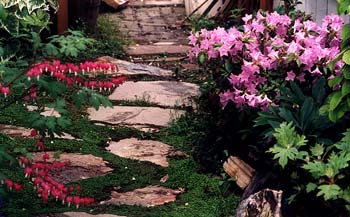 Korean Azalea
Korean Azalea
'Poukhanense Compacta'
"A rock is rolling, falling
over a cliff:
a rhododendron sees it
then today, a thousand years
after that rhododendron withered & faded
a pine tree on that cliff sees the rock."
-Moon Dok-soo,
b. 1928, Korea
b. 1928, Korea
Rhododendron poukhanense has had its name changed to R. yedoense var. poukhanense, but that has not effected this hybrid's cultivar name 'Poukhanense Compacta,' which was the name under which it was sold to us. It is specifically R. yedoense pollinated by R. yedoense var. poukhanense x R. yedoense. Rather an incestuous-sounding little fellow!
Poukhanense alludes to Mount Poukhan in Korea, & Yedoense means "from Edo," i.e., Tokyo.
We obtained ours in 2001 when it was only about 20 inches tall & equally wide; two blooming seasons later it was not much taller but about four inches wider. Its average ten-year size is a scant three feet tall & four wide, growth being quite slow. The pure species shrubR. yedoense will reach six feet high, & (rarely) as much as twelve feet wide. But 'Poukhanense Compacta' is a narrower somewhat more densely leafed variety that will be an awful long time reaching four or five feet high & wide.
 "Somewhat more densely leafed" is still fairly loosely leafed, with its upright limb structure visible. Though it can be fully evergreen in milder climates, & fully deciduous in climates colder than ours, it is semi-evergreen here in the Northwest.
"Somewhat more densely leafed" is still fairly loosely leafed, with its upright limb structure visible. Though it can be fully evergreen in milder climates, & fully deciduous in climates colder than ours, it is semi-evergreen here in the Northwest.The leaves turn burgandy or reddish-bronze in autumn & are quite pretty for a while. In 2003, the leaves turned bright yellow in the center, surrounded by burgandy, which was startlingly ornate & nothing like its autumn colors previously. You can see this on the 'Poukhanense Compacta' page of the Autumn Azalea Garden Walk.
By the end of winter the shrub can look a bit scruffy, unlike 'Oceanlake' or 'PJM Elite' which remain more strongly leafed through winter with leaves that turn respectively a rich black-plum & bright mahagony.
About mid-April it has enough of its leaves back, & the buds are large & fully colored, so that its late-winter mediocrity is repaired & it begins to look like one of the best azaleas in our gardens. It has an almost "starburst" limb structure that is most appealing. On our specimen this starburst is roundish but slightly flattened on top, without having been pruned to achieve its rather even shape.
Though a hardy plant, the variety is somewhat susceptible to root-rot, so when I planted it, I built it a little hill so that it would drain extra well. It likes part shade to full sun, & we probably have it at the high end of its shade tolerance for the Pacific Northwest, which has not reduced its heavy production of flowers.
In the afternoons the light purple flowers are very fragrant. They are at their height of beauty for three weeks in May, when the flowers can be thicker than the leaves & temporarily hide the limb structure. When the flowers are spent at the start of the last week of the month, they mostly fall from the branches on their own, though some deadheading is necessary.
This variety frequently reblooms in early Autumn, though ours has thus far rebloomed quite feebly with only a few random blooms, nowhere near a full flowering.
See more of this shrub on the
'Poukhanense Compacta' page of the rhododendron blooms gallery
See also the
'Purple Splendor' Azalea
which is derived from this species.
'Poukhanense Compacta' page of the rhododendron blooms gallery
See also the
'Purple Splendor' Azalea
which is derived from this species.